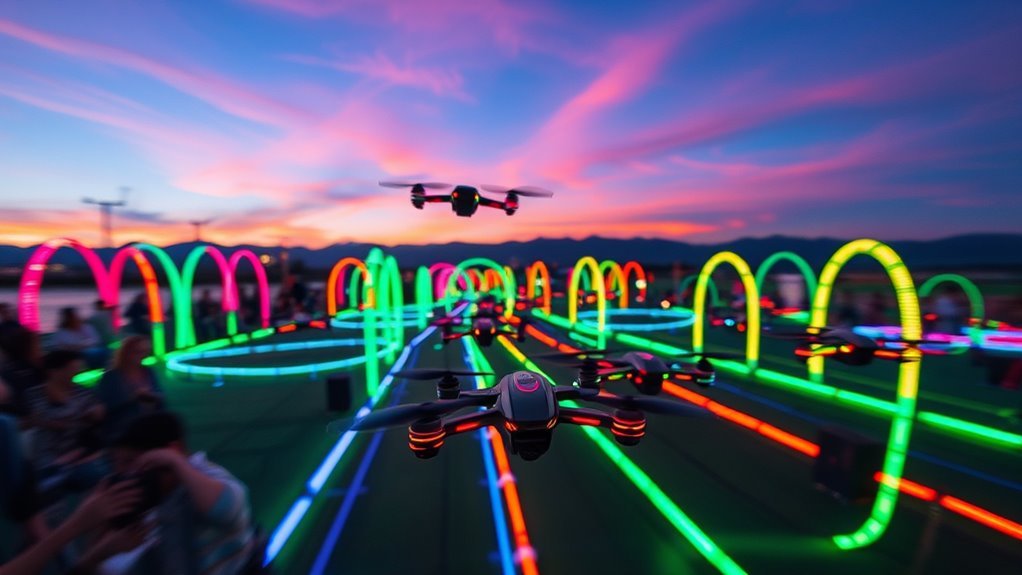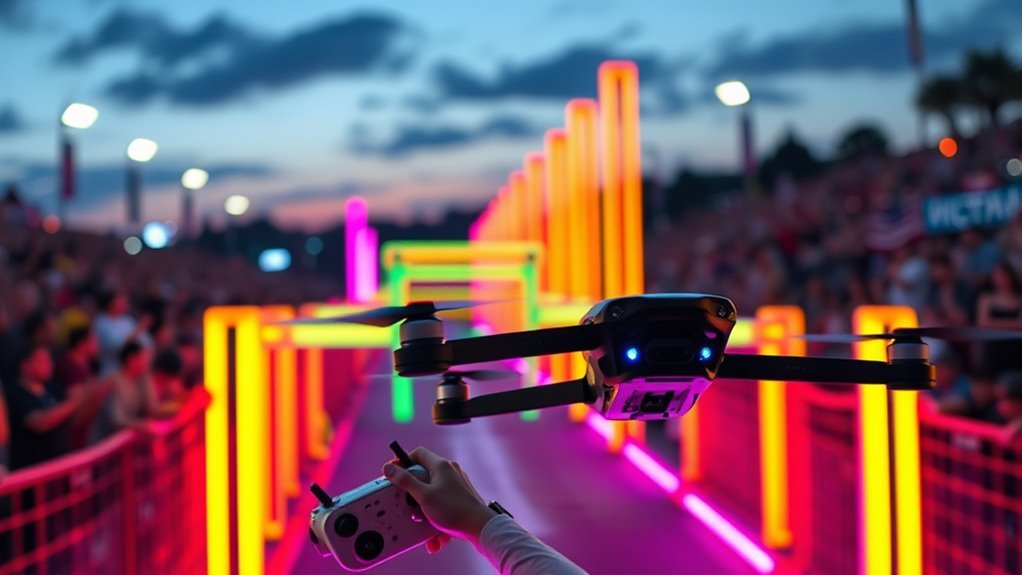Drone racing is defined as a sport through its unique combination of technical skill, competitive spirit, and strong community engagement. You’ll master piloting techniques and adapt to high-speed challenges while maneuvering intricate courses. This thrilling experience is fueled by technological innovations in drone design and equipment. The sport fosters camaraderie among enthusiasts and encourages collaboration. If you’re curious about what else makes this sport engaging, there’s more to discover in the world of drone racing.
The Evolution of Drone Racing

As drone technology advanced, it inevitably paved the way for the emergence of drone racing as a thrilling sport. The history timeline of drone racing began in the early 2010s, when hobbyists started competing in informal races. Key racing milestones include the first organized championship held in 2014, which showcased the potential for competitive racing. As participants pushed the limits of speed and agility, the sport gained traction, attracting sponsors and media attention. Innovations in drone design and piloting techniques further fueled the excitement, transforming drone racing into a professional arena. Today, you see leagues and events worldwide, offering enthusiasts a chance to embrace their passion for flight and competition, embodying the spirit of freedom that drives this exhilarating sport. Understanding material composition is vital for strategizing flight paths in racing to minimize interference and maximize performance.
Skills Required for Success

To excel in drone racing, you’ve got to master a unique blend of skills that go beyond just flying. Technical proficiency with your equipment, quick decision-making during races, and exceptional physical coordination are essential for maneuvering challenging courses at high speeds. Understanding and honing these skills will set you apart in this thrilling sport.
Technical Proficiency
While mastering the intricacies of drone racing may seem challenging, developing the necessary technical proficiency is vital for anyone aspiring to succeed in this exhilarating sport. You’ll need a solid understanding of drone mechanics, including how each component affects performance. Familiarity with flight dynamics is equally important; knowing how your drone responds to controls in various conditions can make all the difference. You’ll find that successful pilots adjust their strategies based on real-time feedback, enabling them to navigate complex courses with precision. This technical knowledge not only enhances your racing skills but also fosters a deeper connection to the craft. Ultimately, embracing these technical aspects allows you to release your creativity and freedom while pursuing victory in the thrilling world of drone racing.
Quick Decision Making
Technical proficiency lays the groundwork for success in drone racing, but quick decision making can be the deciding factor in races where every millisecond counts. As a pilot, you’ll face numerous decision making scenarios that demand your attention and instinct. You’ll often find yourself maneuvering tight corners or avoiding unexpected obstacles, requiring split second choices that can either propel you ahead or send you spiraling behind.
The ability to assess situations rapidly and respond accordingly is essential. Your training should emphasize not just technical skills, but also mental agility. Embrace the pressure of the moment, trust your instincts, and remember that in drone racing, the freedom to make quick, informed decisions can lead you to victory.
Physical Coordination Skills
Mastering drone racing requires more than just mental acuity; it demands exceptional physical coordination. Your hand-eye coordination must be razor-sharp, allowing you to control the drone with precision as it zips through challenging courses. Each maneuver demands a seamless connection between what you see and how you react, making split-second decisions essential. Additionally, strong spatial awareness is critical; you need to visualize the drone’s position in relation to obstacles and other racers. This skill helps you anticipate movements and adjust your strategy on the fly, enhancing your competitive edge. With practice, you’ll develop these skills, revealing a level of freedom in your racing that transforms how you navigate the aerial landscape. Embracing this challenge is part of what makes drone racing exhilarating.
The Role of Technology and Equipment

In drone racing, the technology and equipment you choose can make or break your performance. Advanced drone specifications, like lightweight frames and high-speed motors, are essential for gaining a competitive edge. Additionally, cutting-edge racing gear enhances your control and response time, elevating your overall racing experience.
Advanced Drone Specifications
The heart of drone racing lies in the advanced specifications of the machines themselves, where cutting-edge technology and precision engineering converge. To truly understand drone racing, you need to appreciate the diverse drone types and their performance capabilities across various racing formats.
Here are three essential aspects to take into account:
- Weight and Aerodynamics: Lighter drones accelerate faster and maneuver with precision, giving racers a competitive edge.
- Camera Quality: High-definition cameras offer real-time feedback, allowing pilots to navigate complex courses effectively.
- Battery Life: Longer-lasting batteries maximize flight time, ensuring pilots maintain peak performance throughout races.
These advanced specifications elevate the sport, allowing pilots the freedom to push boundaries and redefine what’s possible in drone racing.
Cutting-Edge Racing Gear
Cutting-edge racing gear plays a vital role in the performance and experience of drone racing, influencing everything from speed to pilot control. You’ll find that the latest drone technology, like high-performance motors and lightweight frames, enhances agility and responsiveness, allowing you to navigate intricate courses with precision. Innovations in FPV (first-person view) systems offer crystal-clear video feeds, giving you an immersive perspective that’s essential for making split-second decisions during races. Additionally, enhanced battery technology extends flight times, letting you push the limits without the constant worry of losing power mid-race. As racing innovation continues to evolve, the synergy between pilots and their gear opens up new areas of freedom, enabling you to explore the thrilling world of drone racing like never before.
The Competitive Spirit in Drone Racing
Thrill defines the competitive spirit in drone racing, where pilots navigate high-speed circuits with precision and skill. To truly understand this adrenaline rush, consider the following elements that shape the competitive mindset:
- Focus: Pilots must maintain laser-sharp concentration, blocking out distractions as they maneuver through intricate courses.
- Strategy: Anticipating opponents’ moves and adapting tactics on the fly is vital to securing victory.
- Resilience: Coping with setbacks, whether mechanical failures or tough losses, fuels the drive to improve and excel.
In this exhilarating arena, every race is a test of both mental and physical capabilities, pushing you to your limits. Embracing the competitive spirit in drone racing means embodying a relentless pursuit of excellence and the freedom to soar above challenges.
Strategies for Mastering Race Courses
Mastering race courses in drone racing requires a blend of technical skill and strategic foresight. Focus on course navigation by familiarizing yourself with the layout and practicing track memorization. Develop effective racing tactics to enhance your drone agility, allowing for quick turns and responsive maneuvers. Speed optimization is vital; fine-tune your drone’s settings for peak performance. Incorporate practice routines that simulate race conditions, emphasizing obstacle avoidance to maintain momentum. Visual scanning is essential; keep your eyes on the course while anticipating upcoming challenges. By harmonizing these elements, you’ll not only improve your performance but also embrace the freedom that drone racing offers, allowing you to truly enjoy the thrill of the competition.
The Importance of Community and Collaboration
As you refine your skills on the racecourse, it’s important to recognize that the drone racing community plays a pivotal role in your development as a pilot. Engaging with fellow enthusiasts not only enhances your skills but also enriches your experience. Here are three key aspects of community and collaboration:
- Knowledge Sharing: You’ll benefit from tips and insights that can only be gained through shared experiences.
- Supportive Environment: Find encouragement and motivation in a space where everyone is passionate about drone racing.
- Collaborative Events: Participate in community-driven racing events that foster camaraderie and elevate your competitive edge.
Embracing community engagement and collaboration can transform your journey, helping you soar to new heights and deepen your love for this exhilarating sport.
Events and Competitions That Shape the Sport
While participating in events and competitions, you’ll discover how they shape the landscape of drone racing and influence your growth as a pilot. These experiences are pivotal, as they not only hone your skills but also immerse you in the vibrant world of drone leagues. Engaging with fellow competitors challenges you to push your limits and innovate your techniques. Additionally, spectator engagement at these events elevates the sport’s profile, drawing in enthusiastic fans who appreciate the thrill of high-speed racing. This fan interaction fosters a sense of community, essential for the sport’s evolution. By participating in these competitions, you’re not just racing; you’re becoming part of a movement that champions freedom, creativity, and technological advancement in aviation.
The Global Reach of Drone Racing
Drone racing has rapidly expanded its footprint across the globe, showcasing a unique blend of technology, skill, and community. You might be surprised to learn that this thrilling sport has flourished due to:
- Global Competitions: Events attract pilots from various countries, fostering a competitive spirit that transcends borders.
- International Leagues: Organizations like the Drone Racing League (DRL) and others promote the sport worldwide, creating a structured environment for pilots.
- Local Communities: Enthusiasts gather in grassroots events, forming networks that share knowledge and passion for drone racing.
As you immerse yourself in this exciting world, you’ll notice how it unites people, encourages innovation, and carves out a niche that celebrates both freedom and technology on a truly global scale.
Future Trends and Developments in Drone Racing
With advancements in technology accelerating at an unprecedented pace, the future of drone racing is poised for significant transformation. You’ll likely witness enhanced drone capabilities and immersive experiences through virtual reality. As the sport evolves, sponsorship opportunities will expand, attracting major brands enthusiastic to connect with a passionate audience. However, regulatory challenges persist, as governing bodies work to establish safety protocols and airspace regulations. Furthermore, the integration of AI-driven obstacle avoidance technology could greatly enhance the safety and competitiveness of racing drones. Additionally, European brands’ focus on sustainable materials in drone manufacturing may appeal to environmentally conscious sponsors and spectators.
| Opportunities | Challenges |
|---|---|
| Increased sponsorship deals | Regulatory compliance issues |
| Technological innovations | Safety standards enforcement |
| Global expansion of events | Public acceptance and awareness |
Embracing these trends could redefine not just drone racing, but how we engage in sports as a whole.
Frequently Asked Questions
What Age Can Participants Start Drone Racing?
You might think age restrictions limit youth participation in drone racing, but many organizations allow kids as young as 8 to compete, fostering skills and passion for the sport while ensuring safety and enjoyment.
Are There Specific Weight Limits for Racing Drones?
Yes, there’re specific weight regulations for racing drones, varying by drone categories. You’ll find lighter drones excel in agility, while heavier models might offer stability. Understanding these limits can enhance your racing experience considerably.
How Are Drone Racing Leagues Structured?
You might think drone racing leagues are just chaotic gatherings, but they’re meticulously structured. Most feature diverse league formats and race schedules, ensuring pilots compete fairly while showcasing their skills in thrilling, organized events.
What Safety Measures Are in Place During Races?
During races, you’ll notice strict safety protocols and race regulations in place. These measures guarantee pilots’ safety and protect spectators, fostering an environment where you can enjoy the thrill of drone racing without unnecessary risks.
Can Drones Be Customized for Individual Racing Styles?
Did you know that 70% of racers customize their drones? By employing various customization techniques, you can adjust racing components like motors and frames, tailoring your drone to fit your unique racing style perfectly.

